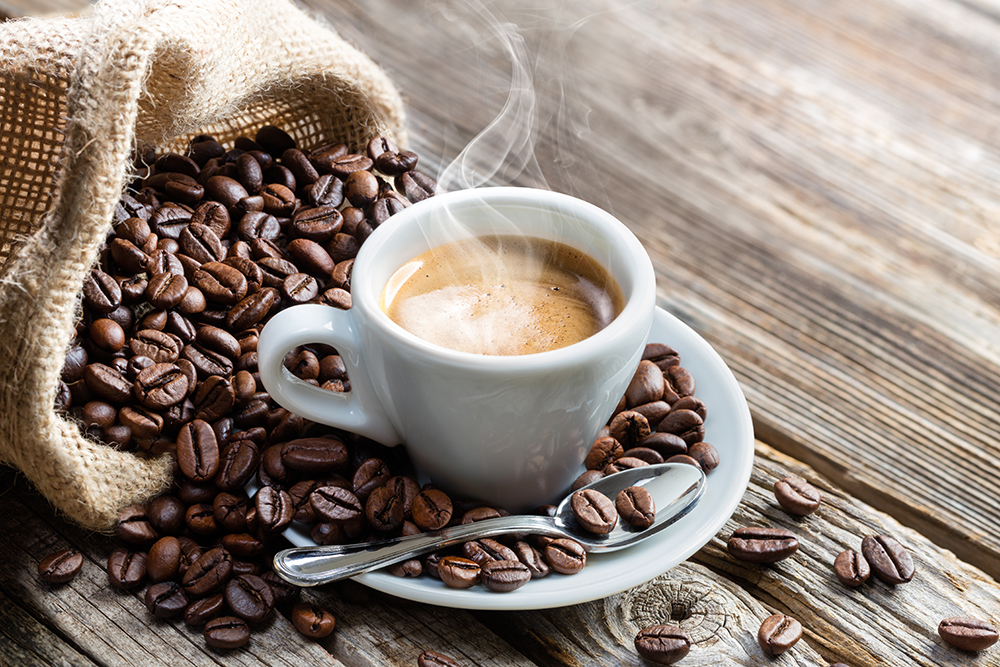Frequent coffee drinkers’ biggest struggle is choosing between regular and decaf coffee. Decaf coffee provides no energy boost, which can sometimes be needed around midday from 2 to 3 p.m. On the other hand, regular coffee contains about 90 to 95 mg of caffeine, which could be too much to consume so late in the day.
At one point or another, a true coffee genius had an idea: creating a mixed blend of decaf and regular coffee beans. Here, the concept of half caff coffee was born, serving as the perfect coffee compromise for situations like these. Below, we’ll answer all of your questions about “what is half caff coffee?” and explore how to shop for high-quality half caff coffee.
What is half caff coffee?

If you don’t know what half coffee is, chances are you already have a pretty good guess based on its name. As the name suggests, half caff coffee contains half the caffeine in regular coffee. Made with a 50-50 blend of regular and decaf coffee beans, this specialty blend of coffee is a staple for many regular coffee drinkers who want to enjoy the flavor of freshly roasted coffee without consuming excessive caffeine.
How much caffeine is in half caff coffee?

The caffeine content in half caff coffee varies depending on the size of the cup you brew and the blend of half caff used. Generally, you can expect each cup to contain about half the caffeine in regular coffee. This means most cups of half caff coffee are likely to have somewhere between 40 and 70 mg of caffeine per cup. However, you’ll need to contact the brand to know the exact amount of caffeine in your half caff coffee.
At an average of about 55 milligrams of caffeine per cup, it’s just enough caffeine to re-energize and get you through the workday slightly, yet not enough to keep you awake at night. Striking a healthy balance between flavor and caffeine content is the ultimate coffee compromise.
Shopping for half caff coffee

Once you discover half caff coffee blends, expect it soon to become a staple at your home coffee bar. However, like regular coffee, not all half caff coffees are created equally. Here are a few things to pay attention to as you shop for half caff coffee, such as:
Decaffeination method
Whenever possible, opt for half caff coffee that contains decaf coffee that has been decaffeinated through a natural method. For example, Kauai Coffee’s half caff coffee blend combines the brand’s Swiss Water Decaf and Yellow Catuai blends.
The Swiss Water decaffeination method preserves the coffee’s original flavor profile and does not use chemicals. Brands that do not use the white Swiss Water decaf method may use harsh chemicals such as methylene chloride or ethyl acetate to decaffeinate the coffee, which can impact the final flavor of your brew.
Roast
Half caff coffee may come in medium or dark roast varieties. A medium roast is great for a milder, gentler taste, whereas a dark roast yields a darker cup with a bolder, stronger flavor. Dark roasts are less acidic than medium roasts, so this choice is based solely on taste preferences. Light roast coffee tends to be harder to find in half caff variety, so you may need to make your own blend if you prefer a lighter, more acidic cup of joe.
Brand reputation
When selecting any coffee brand, it’s always a good idea to pay attention to brand reputation and reviews. Choosing premium brands with sustainable and ethical sourcing practices, such as Fabula’s Half Caff Blend, ensures you get the best-tasting cup possible.
Fabula, for example, tests its half caff coffee for over 350 chemical compounds, toxins, and mold for a super-clean cup of coffee. Unlike many other coffee brands that use pesticides and herbicides, this brand is USDA-Organic certified for a half caff coffee you can feel good about. Researching your half caff coffee brand selection before buying is the best way to learn more about the origins and quality of the beans used.
Reasons to choose half caff coffee

Half caff is the perfect solution for coffee drinkers who want to moderate their caffeine intake. It has less caffeine than a standard cup but more than a decaf cup, so it’s a good option for drinking coffee from late afternoon to early evening. Or perhaps you need to stay up for a nighttime occasion and just a bit of extra caffeine to get through the day. All in all, there are endless scenarios where caff coffee can come in handy to control your caffeine consumption for the day.
In addition, some say the blend of regular and decaf beans provides a more prosperous and deeper taste than just decaf coffee—a common concern among decaf coffee drinkers. You’ll still get a slight caffeine boost from half caff coffee but don’t expect to be jumping off the walls. For those consuming more than the recommended daily caffeine limit, switching to half caff coffee may help improve sleep and reduce anxiety, jitters, and other caffeine-related side effects.




